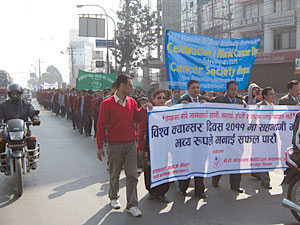 |
When we were studying medicine we refereed to cancer as the "Big C". Recently the New Delhi-born Siddhartha Mukherjee's debut book 'The Emperor of All Maladies: A Biography of Cancer' (Scribner) has galvanised international attention on the Big C. The good doctor author practises oncology in New York, and writes magnificently.
Egyptians knew about tumours and the Greeks even differentiated benign tumors (oncos) from malignant ones (carcinos). Similar to Vedic thinking, Galen in the second century AD, proposed that poor diet (probably non-vegetarian) and environmental factors triggered malignancy.
In the past we only suspected people had cancer, but now with imaging techniques (x-rays, ultrasound, CT, MRI scans) we can see the actual, sinister growth. In 1970 in America, President Nixon was feeling tired of the Vietnam War and realised how much the war drained away the mental and physical resources of the country, not unlike the present effect of the Afghan War in the US.
However "Tricky Dick" as Nixon was known, had a plan: he declared war on cancer in the hope that this would be a more popular move that could result in an unambiguous victory, compared to the other war he was faced with. Nixon's war against the dreaded disease pushed it into the limelight and provided more political and financial support for research, diagnosis, and treatment with a universal impact.
Treatment of cancer boils down to burn (radiation), slash (surgery), or poison (chemotherapy). But over the years, research has made it possible to deploy highly targeted relatively non toxic-chemotherapy guided by genetics. Gleevec (imatinib is the pharmacological name) used against a special kind of leukaemia calledchronic myeloid leukaemia (CML) is the poster boy for cancer medicine. Gleevec's working mechanism is genetic based, so that unlike other cancer drugs which indiscriminately kill off all dividing cells (hence people on chemotherapy may go bald), gleevec targets a particular cancer cell. Gleevec is free for patients in Nepal.
Many doctors are pessimistic about the war on cancer partly because thousands of symptom-free people have to be screened with attendant anxieties, costs, and risks to prevent even one death. However, it is reassuring that Mukherjee allows himself hope. He should know because as a cancer doctor, and has the inside track.
His book is a biography of cancer itself, tracing its history that is almost as old as human history. He narrates the stories of cancer patients, how they deal with the diagnosis and treatment. He was inspired by a patient with stomach cancer who asked him to give it to her straight: whether it was worth the trouble and pain of treatment.
Mukherjee also delves into the new treatments that are in the pipeline, and how fast research is moving parallel at many levels. The book is a doctor's eye view of the disease, with both the sadness and triumphs of treating the afflicted.


